
HOME | NEWS | INTERACTIVES | FEATURES | STORE

HOME | NEWS | INTERACTIVES | FEATURES | STORE
New Bird-Like Dinosaur Related to Archaeopteryx
Three Feathered Tyrannosaurs Discovered
Woolly Mammoth DNA Adapted for Ice Age Survival
Rare Find: Three New Dinosaurs From Australia
Flute Belonged to Early Humans
Jurassic Dino Provides Clues to Bird Wing Evolution
Hobbit-Like Human Ancestor Found
Evolution Can Occur in Less Than Ten Years
Gigantic Trilobite Fossils Found in Portugal

Location: Inner and Outer Mongolia in central Asia
Time: Late Cretacious approximately 71 to 75 million years ago
Diet: Carnivore
Classification: Family Dromaeosauridae, Suborder Theropoda, Order Saurischia, Superorder Dinosauria
Size: Length 6.8 ft (2.07 m), Height 1.6 ft (0.5 m)
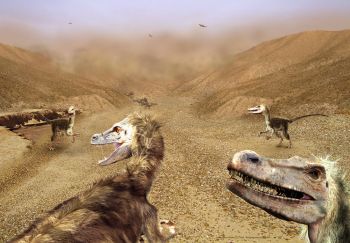
Own this velociraptor poster - Only $15!
Velociraptor was a bipedal feathered dinosaur that lived during the later part of the Cretacious period approximately 71 to 75 million years ago. Velociraptor fossils have been found in both Inner and Outer Mongolia in central Asia.
Part of the family dromaeosauridae, the Velociraptor has two recognized species: V. mongoliensis and V. osmolskae. A carnivore, the Veloricaptor had a sickle-like claw on each hind foot that it used to kill its prey.
A distinguishing feature of the Velociraptor is its upturned snout and long skull. The skull which could be up to 9.8 in. long (25 cm) was up-curved, concave on the upper jaw and convex on the lower. The jaws contained 26-28 serrated teeth on each side, with the sharper serrations on the back side of each tooth. It is thought that the stronger serrations allowed the velociraptor to catch and grasp fast moving prey.
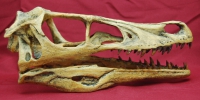
Own your own velociraptor skull replica
The Velociraptor had a large manus ("hand") with three curved claws that resembled the wing bones of modern birds in their construction and flexibility. The first of the three digits was the shortest, while the middle digit was the longest. Like many other theropods the velociraptor had a small dewclaw, but unlike other theropods that had three digits touching the ground, the Velociraptor walked on the third and fourth digits. The second digit, the claw for which the Velociraptor is most famous, was drawn back from the ground and was most likely used in hunting and killing its prey. The claw was large and could be more than 2.6 in (6.5 cm) long around the outer edge. This type of large sickle-shaped claw was common in dromaeosaurids and troodontids.
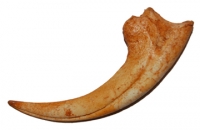
Own this replica velociraptor killing claw
The Velociraptor's vertebrae had bony projections (prezygapophyses) and ossified tendons that helped to straighten and stiffen the tail. The prezygapophyses were on the upper portion of the tail and started at the tenth tail vertebra (caudal), while the tendons were underneath the tail. The prezygapophyses extended forward to brace four to ten vertebrae. Once stiffened, the tail acted like one rod-like unit which prevented any vertical movement between the vertebrae. One specimen that was found has preserved the tail in a "S" shape which suggests there was more flexibility horizontally which likely aided in balance and stability while the Velociraptor was turning at high speeds.
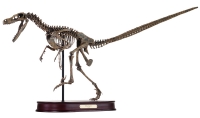
Own this half scale replica skeleton
The first Velociraptor fossil was found by an expedition of the American Museum of Natural History in 1922 to the Gobi Desert. This find was a complete but crushed skull and was associated with a raptorial second claw. In 1924 Henry Fairfield Osborn, the museum president, named his type species V. mongoliensis after its country of origin and designated the skull and claw the type specimen of the new genus Velociraptor. The name Velociraptor is derived from two Latin words, velox ('swift') and raptor ('robber' or 'plunderer'). These words describe the cursorial nature and carnivorous diet of the animal.
Several expeditions took place throughout the remainder of the Twentieth Century. During the Cold War North American expeditions were blocked from Mongolia, while Soviet & Polish expeditions collaborated with Mongolian teams to recover several more Velociraptor specimens. The legendary "Fighting Dinosaurs" specimen, which is considered a national treasure of Mongolia, was discovered in 1971 by a Polish-Mongolian team and shows a Velociraptor battling against a single Protoceratops. Between 1988 and 1990 additional Velociraptor fossils were discovered by a Chinese-Canadian team in northern China. In 1990 a joint Mongolian-American team returned to Mongolia. The team which was comprised of scientists from the American Museum of Natural History and the Mongolian Academy of Sciences recovered several well-preserved fossils. During this expedition there was a specimen found to be fairly complete, with the exception of the head. This earned the fossil the nickname "Ichabodcraniosaurus" by the recovery team which alluded to the Washington Irving character from "Sleepy Hollow," Ichabod Crane, the "headless horseman."
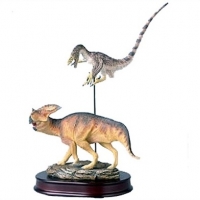
Own this 1/35 scale model of velociraptor attacking protoceratops
The Velociraptor was probably warm-blooded since it seemed to require a lot of energy to hunt. Modern animals with furry or feathery coats are also warm-blooded. These types of coats provide insulation from the elements. In 2007 paleontologists reported the discovery of quill knobs on the forearn of a well-preserved Velociraptor mongoliensis found in Mongolia. According to paleontologist Alan Turner this confirms that Velociraptor had modern wing-style feathers. Since Velociraptor is thought to have been flightless, it is possible they used their feathers as a means of gaining speed and thrust while running up inclines, or to cover their nests.


Free Book Download:
Geologic History of West Virginia by Dudley H. Cardwell (1977)
>> Download the Book